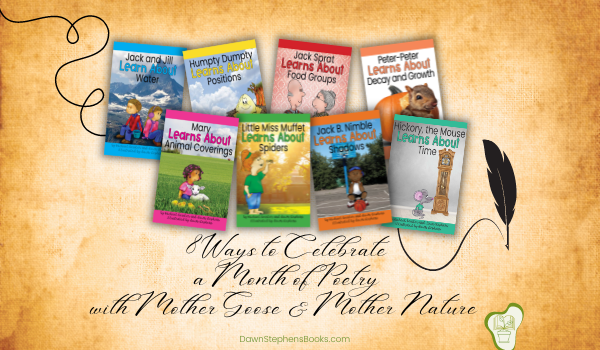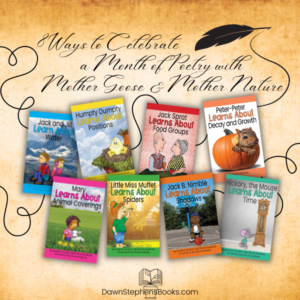8 Ways to Celebrate a Month of Poetry with Mother Goose Nursery Rhymes
April is poetry month. It is a great time to help our children learn to appreciate and understand poems and various forms of poetry. Children need to know and understand poetry. The Bible itself contains poetry. In fact, 30% of the Bible is made up of ancient poetry. Therefore, exposing our children to poetry will help them understand scripture. Likewise, understanding scripture and reading biblical poetry will deepen their relationship with their creator. Nursery Rhymes are a great way to begin.
A great place to begin learning poetry is with Mother Goose Rhymes

When my grandmother was little, she learned to recite hundreds of poems. To this day, I can still remember many of them. It was common for children to learn and recite poetry. Then, when they began learning to read they would be able to associate the sounds of words with the text. Rhyming poetry helped in this process. Therefore, nursery rhymes, or what is known as Mother Goose rhymes were very very popular.
When I taught kindergarten and preschool, I knew that helping the children learn traditional rhymes would make it easier for them to learn to read. Because there was much more to teach than reading, my colleague and I rewrote the poems to include scientific and mathematical concepts. I have made these new nursery rhyme lyrics into a set of downloadable books. They are called the Mother Goose Meets Mother Nature series and include eight Mother Goose Rhymes.
1. Jack and Jill Learn About Water

In the traditional lyrics of this rhyme, Jack and Jill go up a hill to fetch a pail of water. In our version, Jack and Jill hike up a huge hill that is more like a mountain. They go high enough that they are not filling their pails with water, but with snow and ice. When they return back down the mountain, they discover the ice has melted into water. Discovering that it is the temperature that changes the state of the water, they apply more heat, boil the liquid and make steam.
2. Mary Learns About Animal Coverings

In the nursery rhyme, Mary had a Little Lamb, the lamb’s wool is referred to as fleece. Helping a child to learn about fleece and wool is a great start to children learning about different animal coverings. In our version, Mary has one lamb. Then she has two snakes, and finally three birds. The book purposely follows a sequential order of 1, 2, and 3, so that children will be inspired to continue the pattern with additional numbers and other animals. The three types of animals chosen (a lamb, snakes, and birds) were selected to illustrate fur, scales, and feathers. In science, children discover that God created animals with different coverings for the purpose of adapting each species to different habitats. This book pictures different landscapes to help children identify not just an animal’s body covering, but its habitat as well.
3. Humpty Dumpty Learns About Positions

In the traditional lyrics of Humpty Dumpty, an egg is sitting and falling off a wall. In our version, the egg is a baby eagle and is sitting on a very high ledge where an eagle nest is located. The eggs are baby eagles or eaglets. The new text teaches children positional words that are also opposites. Children need to understand and use these words in Science so they are able to describe the relationships that objects have to one another and the perspective of their observations. In the story, Humpty decides to go out of the nest and hang his feet over the edge, The other eggs want Humpty to get back in the nest. But, Humpty breaks out of his shell, and flies above, under, and around. Not only does Humpty learn positional words, but he also motivates children to try their best.
4. Little Miss Muffet Learns About Spiders

We are sometimes afraid of the things we do not understand. Therefore LIttle Miss Muffet must learn more about spiders to help her overcome her fear of them. In this version of the poem, she compares and contrasts a spider to an insect and learns the differences between them. Children learn about the specific number of body parts for each. They also learn the number of legs and eyes for spiders and insects.
5. Jack B. Nimble Learns About Shadows

Instead of jumping over a candlestick, Jack is trying to jump over his shadow. Before Jack can understand if he is able to jump over his shadow, he first must learn the science of where shadows come from. The lyrics within this rhyme teach students what makes a shadow and that it must move with its source. A great activity after reading this book is to take the children outside and see if they can jump their shadows.
6. Jack Sprat Learns About Food

Jack Sprat ate no fat and his wife would not eat lean. In our version, Jack helps his wife to understand the different food groups. In this text, children learn what a healthy diet includes. Mrs. Sprat prepares a well-balanced meal for Jack that includes meat, milk, cheese, fruit, vegetables, and bread. However, Mrs. Sprat will not eat the meat, Therefore, Jack explains that she is missing important protein, and offers her nuts and beans as a substitute. The new lyrics help children learn and understand the science behind a healthy and nutritious diet.
7. Peter Peter Learns About Decay and Growth

Peter Peter put his wife in a pumpkin shell? That is an odd thing to do until you realize that in our version Peter Peter is a squirrel who loves eating pumpkins so much that he wants his wife to live in one. However, pumpkins make terrible homes because they rot and decay. Peter Peter learns all about this process and how new pumpkins can grow.
8. Hickory, the Mouse Learns About Time

In this Hickory Dickory Dock nursery rhyme, Hickory is a mouse who learns that his day follows a routine. His routine follows time. Children will learn that telling time is important because it helps us move through our day with purpose.
These books are available at DawnStephensBooks.com and on the Teachers Pay Teachers website. There are also teacher resources available for some of the books. Be sure to subscribe on the right-hand side to receive updates on each new post within this Christian Children’s Authors blog. Follow us for books news, free resources, parenting tips, and encouragement!
And, if you want more information about the Mother Goose meets Mother Nature resources as well as how to grow the fruit of the Spirit submit your name and email here:
This blog was written by Dawn Stephens.
#christianchildrensauthors #christianbooks #christianauthors #christianwriters #christianteachers #christianbooksforkids #christianchildrensbook #christianchildrensbooks #christianhomeschool #monthofpoetry #poetrymonth #nurseryrhyme #dawnstephensbooks #dawnstephens #fruitofthespirit #mothergoose #mothernature


Thank you so much for sharing these ideas and these interesting books with us. What a wonderful way to teach important facts to the children. I look forward to reading some of these!